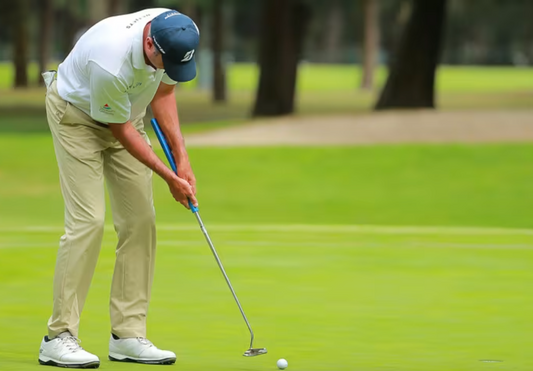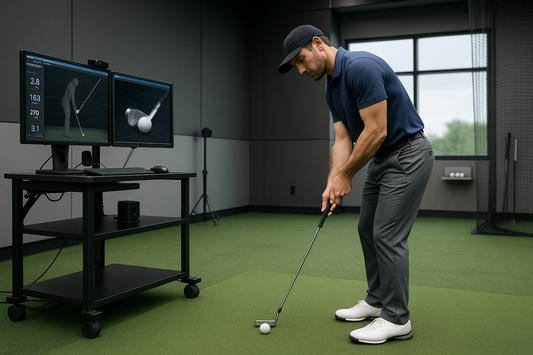I had a student a couple of years back who fought the putting yips for two years. This 12-handicap stood over three-foot putts with his heart pounding, hands shaking, knowing he was probably going to miss. Traditional putting advice wasn't helping — if anything, it was making things worse.
Then I watched Matt Kuchar putt using a unique style, and everything changed in how I was going to approach helping him.
Arm-lock putting looks weird the first time you see it. The putter grip extends up your lead forearm, creating a direct connection between the club and your body. It violates everything you've been taught about putting fundamentals.
It also works.
The Setup That Changes Everything

Image courtesy of PGATour.com. (Photo by Hector Vivas/Getty Images)
Your lead arm stays relatively straight throughout the stroke, with the putter grip pressed against your forearm somewhere between your wrist and elbow. Finding that exact spot is crucial. It needs to be consistent every time, or the method fails.
I've seen golfers mark their forearm with a Sharpie to ensure consistency. Whatever it takes.
The feel is entirely different from traditional putting. Instead of coordinating hands, wrists, arms, and shoulders independently, you're essentially turning your lead arm and the putter into one piece. Fewer moving parts mean fewer opportunities for things to go wrong.
Why It Works (When It Works)
The biomechanics are sound. Traditional putting requires precise coordination between multiple body parts, each capable of introducing inconsistency. My student was like an uncoordinated toddler trying to thread a needle with too many moving parts, all working against each other.
Arm-lock putting simplifies this by eliminating much of the hand and wrist action that causes problems. The putter face stays more stable throughout the stroke because it's connected to your forearm rather than just held in your hands. For golfers who struggle with face control — particularly those prone to flipping or manipulating the putter through impact — this connection provides remarkable stability.
The Learning Curve Is Real
Don't expect immediate improvement. My student putted worse for about three weeks before things clicked. He four-putted from twelve feet during one particularly brutal practice session and honestly questioned whether I'd lost my mind.
The distance control feels completely different. What used to feel like a six-foot stroke might now roll the ball eight feet or four feet until you recalibrate. I told my student that the feedback mechanisms had changed entirely. Trust me on this one, it's disorienting at first.
The mental adjustment is as significant as the physical one. Some golfers find the connection restrictive, like they've lost their "feel" for putting. Others discover that the increased stability actually enhances their confidence and touch.
Equipment Matters More Than You Think
You can't just press any putter against your arm and expect success. Arm-lock putting typically requires longer putters — often 40+ inches compared to the standard 34-35 inches. The lie angle becomes critical because the arm-lock setup changes how the putter sits at address.
My student went through four different grips before finding one that felt comfortable against his forearm. Many golfers need putters with more upright lie angles to get proper contact with the arm-lock method. Don't cheap out on this part — the equipment investment is real but necessary.
The Rules Reality
Current rules allow the putter to be held against your forearm but prohibit anchoring it against your body in ways that create a fixed pivot point. The distinction matters, especially if you compete in organized events. Know the rules before you commit to the method.
I've seen players get called out in tournaments for improper anchoring. Not fun.
When It Makes Sense

Arm-lock putting isn't for everyone, but it's particularly effective for certain types of putting problems. If you struggle with:
-
Inconsistent face control
-
Hand and wrist action that you can't quiet
-
The yips or putting anxiety
-
Maintaining consistent stroke tempo
Then arm-lock putting might provide the stability you need.
My Honest Assessment
Arm-lock putting saved my student's game and probably saved his enjoyment of golf, too. Six months after switching, he shot 79 with 27 putts.
The stability it provides allowed him to trust his stroke again, which is invaluable when you've lost confidence on the greens.
But it's not magic. It requires proper equipment, patience during the learning process, and acceptance that it might not work for your particular putting issues.
If traditional putting methods aren't working for you, arm-lock putting deserves serious consideration. Just be prepared to commit to the learning process and potentially endure some short-term scoring increases while you adjust.
For my student, those few weeks of struggle were well worth the years of putting confidence that followed.




